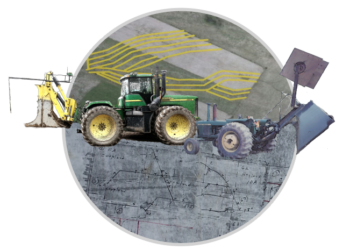Robert & Edna Swartley moved to Romulus, NY in Nov of 1970. Their new farm had over 50 acres out of 235 that was nearly unfarmable due to wet soils. Some of it would have been considered wetlands today. Cooperative Extension and Soil & Water recommended drainage for that acreage. The farm has Romulus Clay soil from which clay tiles had been made prior to their ownership of the property.
Tile plows were just coming into the drainage business in the early 1970s. Robert, compared dirt moved by tile plow to that of a moldboard plow and thought that he could model the lifting action of a moldboard plow to a tile plow. At the time, other tile plows tried to wedge dirt to the side which took tremendous power and traction. With $350 of new and used steel he built his first tile plow during the summer of 1973 and pulled it with a John Deere 4320 2wd tractor. In greasy conditions, he would hook our John Deere 4020 to it to assist. That summer he installed 45,000 feet of drain tile.
Grade was controlled by the” Stake and String method”. Stakes were pounded in the ground every 50 feet and then surveyed, grade calculated, then a string put to grade on the stakes. The plow utilized a balance beam pointer that hung off to the side and was kept near to the string by “healing” or “towing“ the plow as it skid on the bottom of the furrow. Grade was checked by Soil & Water with help from Cornell University.
If my memory is correct, installing clay tile cost approximately $0.40 per foot with open trenching being $0.25 per foot and the clay tile at $0.15 per foot at the time. Robert bought the plastic drain pipe for $0.08 per foot and installed himself. He saved over $14,000 that year which was a lot of money in 1973.
With no experience in installing drainage tile, Robert worked closely with the Soil & Water and Cooperative Extension offices of Seneca County. With the work load of the entire County, the Soil & Water Engineers were unable to keep up with the installation pace Robert set. It soon became apparent that he needed outside help. A retired USDA Soil Conservation Service, District Conservationist Emil Kahabka was recommended to assist in system design and grade survey work. After several years of this assistance Robert and 3 sons, Gerald, Kevin and Rodney, became proficient at layout and installation. In 1980, Kevin and Robert added a larger 4wd tractor to the lineup and completed a major redesign to the tile plow.
Over the subsequent years much more drainage was added to the acreage owned and leased by the Split Pine Farms. Owners of the leased land were excited to work with us to improve their property. With neighbors seeing our progress, they hired us to design and install drainage systems on their properties. Thus, we entered the drainage business in the late 1980s.
In 1993 the operation moved to laser for control of tile plow and surveying. Kevin, took a Laser grade survey training short course put on by Land Improvement Contractors Association (LICA). Around the same time, a redesign of the tile plow gave us improved depth capabilities and the ability to direct lay 6” pipe. We also moved to using maxi coils of tile, building our own tile stringer to load and unroll these larger coils. All this improved efficiency dramatically.
In the 1990s GPS came to the operation with simple no-RTK mapping and parallel tracking for layout of patterns for tile.
In the early 2000s, Robert and Kevin were working over 2000 acres of primarily corn, wheat, and soybeans. By 2006, Robert had retired and Kevin made the decision to go into fulltime drainage installation. Working in a three-county area, the business continued to expand.
In 2013, Kevin’s eldest son Kyle returned from an engineering career to rejoin the business. Again, a design update brought us more strength, depth, and tile size to our capabilities. The latest design iteration of our plow has the capability of installation depths of over 6 feet and can direct lay 4”, 6”, and 8” tile. It also has removable and rebuildable wear pieces that reduce down time when those wear pieces need to be rebuilt. At the same time, we moved to RTK-GPS for auto-steer and total plow control. A newer articulated tractor came with this update.
The business incorporated in 2015 and is now beyond our three-county area and still expanding working in dairy, row & vegetable crop, and vineyard drainage as well as ultra-deep subsoiling (~4 feet deep) for grapes.

